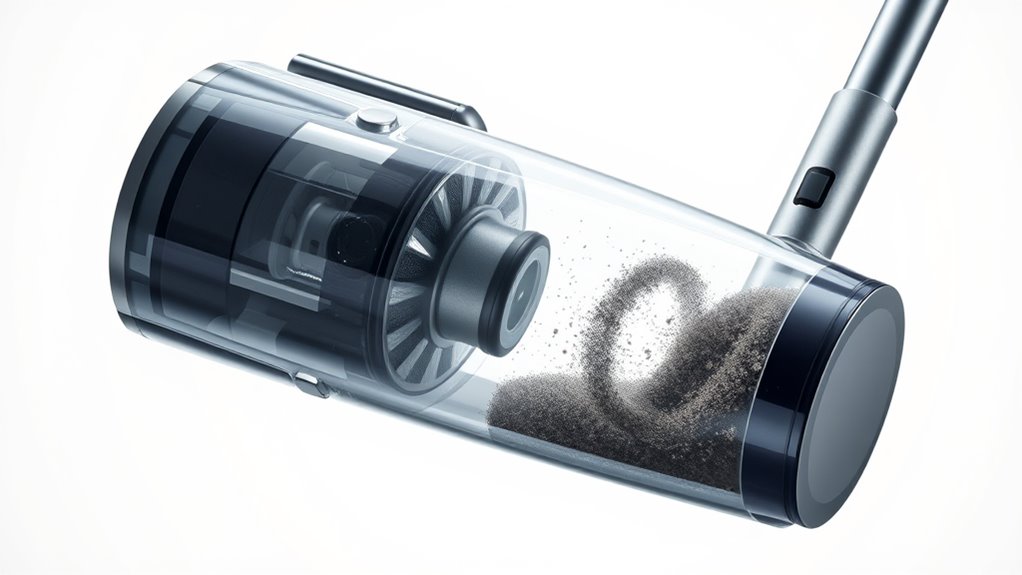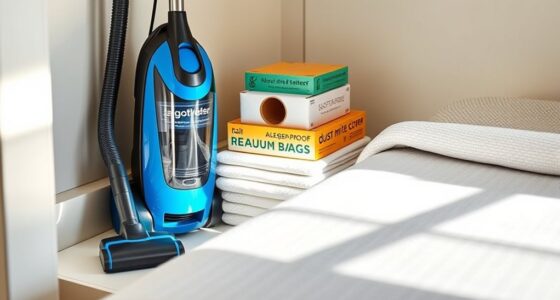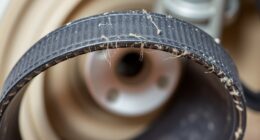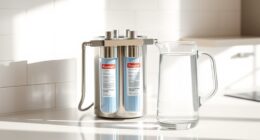Cyclone technology uses a spinning airflow to separate dust and debris from the air, reducing clogs and maintaining strong suction. Instead of relying solely on filters, the system creates a vortex that pushes dirt outward into a bin, keeping airflow clear and motor parts protected. This design leads to more powerful, durable vacuums that need less maintenance. Keep exploring to discover how these innovations can improve your cleaning both now and in the future.
Key Takeaways
- Cyclone technology uses spinning airflow to separate dust and debris, reducing reliance on filters and maintaining consistent suction.
- Proper design of inlet, cyclone chamber, and dust bin maximizes efficiency and prolongs vacuum lifespan.
- It creates a vortex that pushes dirt outward, causing it to fall into the collection bin via centrifugal force.
- Cyclone vacuums are durable, capable of handling heavy use, and offer features like multi-stage filtration and low noise operation.
- Future innovations focus on quieter, lightweight, and smarter vacuums with improved dust control and clog prevention.
The Basics of Cyclone Technology: How It Differs From Traditional Vacuums
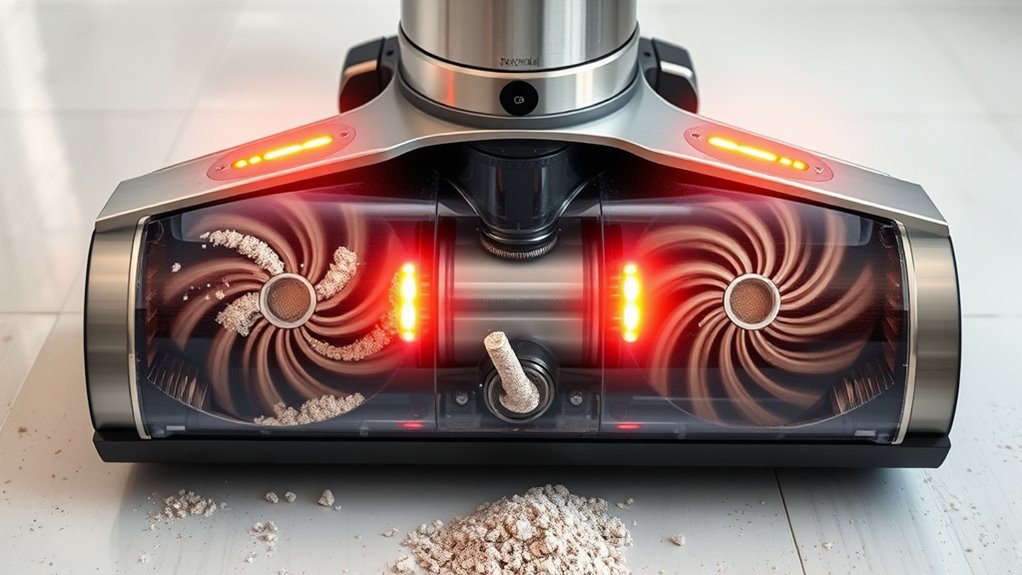
Cyclone technology revolutionizes vacuum cleaners by using a powerful spinning motion to separate dirt and debris from the air. This design enhances dust capacity, allowing you to vacuum longer without frequent emptying. Unlike traditional vacuums that rely on bags or simple filters, cyclone systems maintain consistent suction because they don’t clog easily. The motor efficiency also improves since less energy is wasted overcoming airflow restrictions caused by dirt buildup. As a result, your vacuum operates more effectively with less power, saving energy and extending motor life. You’ll notice better cleaning performance and less maintenance over time. This innovative approach guarantees you get a deeper clean while maximizing dust capacity and optimizing motor efficiency, making cyclone vacuums a smarter choice for your floor care needs. Understanding how cyclone technology works can help you appreciate its benefits even more.
The Science Behind Cyclone Separation: From Airflow to Dirt Removal
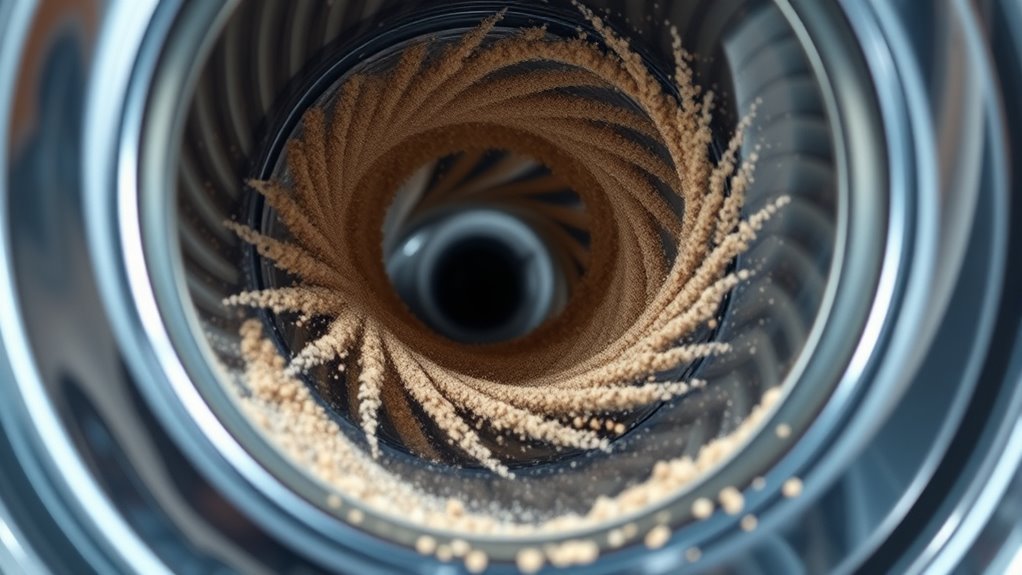
Understanding how airflow moves inside a cyclone helps you see how dirt gets separated efficiently. As air whirls rapidly, it creates forces that push debris toward the walls, where it drops into the collection bin. This process combines airflow dynamics and dirt separation mechanics to keep your space clean. Proper maintenance of the cyclone system ensures optimal performance and longevity.
Airflow Dynamics Unveiled
Have you ever wondered how a cyclone separates dust from the air so effectively? It all comes down to airflow dynamics and cyclone design. The airflow patterns inside create a powerful vortex that spins debris outward. This is how dirt is separated from the air stream. Your vacuum’s cyclone design directs airflow to maximize efficiency. Here’s how it works:
- Air enters tangentially, creating a spinning motion.
- The vortex forms, pushing larger debris outward.
- Air spirals upward, carrying finer dust.
- Clean air exits through the center, leaving dirt behind.
- The headphone jacks help maintain secure connections for audio devices, ensuring consistent performance during operation.
Understanding these airflow patterns helps explain why cyclones perform so well at dirt separation. The smart cyclone design guarantees airflow stays controlled and focused, making your vacuum more effective.
Dirt Separation Mechanics
The key to a cyclone’s dirt removal efficiency lies in how airflow patterns create separation. As air spirals rapidly inside the cyclone, centrifugal force pushes dirt and debris outward toward the cyclone walls. This process minimizes reliance on filters for initial dirt capture, reducing filter maintenance needs. The separated dirt then falls into a collection bin, keeping airflow unobstructed. Proper design ensures that airflow remains smooth, which also helps keep noise levels low during operation. If airflow becomes turbulent or dirt accumulates unevenly, it can increase noise and decrease separation efficiency. Maintaining the cyclone’s interior and ensuring the cyclone’s shape is intact are essential for consistent dirt separation. Additionally, the use of high-efficiency models can optimize energy use and improve overall performance. Ultimately, understanding these mechanics helps you appreciate how cyclone technology cleanly and quietly removes debris without clogging filters.
Designing a Cyclone System: Key Components and Their Functions

Designing a cyclone system involves selecting and integrating several key components that work together to efficiently separate particles from airflow. First, the dust bin collects the debris after separation, preventing clogging and maintaining airflow. Second, the cyclone chamber is the core where dust is spun outward, separating particles via centrifugal force. Third, the inlet directs the airflow into the cyclone chamber, ensuring ideal particle separation. Fourth, the outlet allows clean air to exit, keeping dust confined within the dust bin. Proper design ensures these components function seamlessly, maximizing efficiency and filtration. When you focus on these parts, you’ll create a system that effectively captures dirt, reduces maintenance, and prolongs the vacuum’s lifespan. Each component’s role is vital in achieving a high-performance cyclone system. Additionally, considering filter maintenance is crucial as regular upkeep prevents performance decline and extends the device’s operational life.
Benefits of Cyclone Technology: Power, Efficiency, and Durability
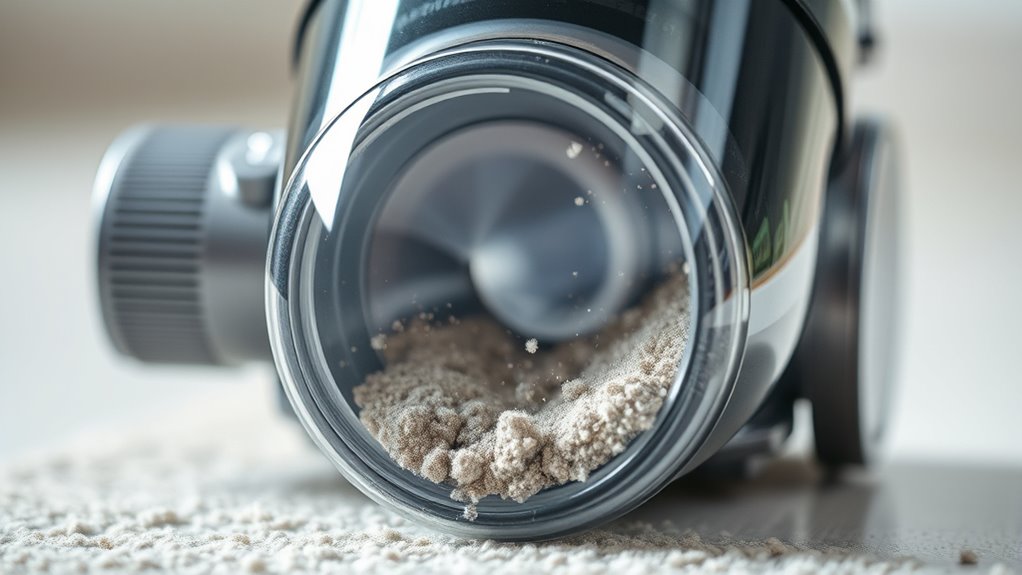
Cyclone technology offers you increased suction power, making cleaning more effective with less effort. It also reduces maintenance needs, saving you time and money over the device’s lifespan. Plus, its durability means your equipment lasts longer and performs reliably.
Enhanced Suction Power
Have you ever noticed how some vacuum cleaners seem to lose suction over time? That’s where cyclone technology excels. It provides consistent, enhanced suction power by maintaining airflow optimization, so dirt doesn’t clog the system. This results in better dirt pick-up and less loss of power. Here’s how cyclone technology achieves this:
- Suction enhancement through powerful cyclonic airflow
- Airflow optimization to prevent clogs and maintain performance
- Reduced loss of suction over prolonged use
- Efficient dirt separation that keeps filters cleaner and airflow steady
Reduced Maintenance Needs
Thanks to cyclone technology’s ability to maintain consistent airflow and prevent clogs, your vacuum cleaner requires less frequent maintenance. Since filters stay cleaner longer, you spend less time on filter maintenance and fewer replacements. The reduced buildup also means the vacuum runs more quietly, contributing to noise reduction during operation. This efficiency not only saves you effort but also helps keep your device in top shape for longer periods. With fewer blockages and less strain on motor components, you’ll notice fewer interruptions and less need for repairs. Overall, cyclone technology simplifies your cleaning routine by minimizing the need for regular upkeep, ensuring your vacuum remains powerful and quiet without constant attention. Incorporating regular vacuum maintenance, such as cleaning filters and checking components, can further prolong the lifespan of your device.
Longer Device Lifespan
Because cyclone technology reduces strain on your vacuum’s motor by preventing clogs and maintaining consistent airflow, your device is less prone to wear and tear over time. This means a longer device lifespan, saving you money and effort. With cyclone systems, you can explore dust bag alternatives, reducing the need for frequent replacements. Plus, modern models often incorporate noise reduction techniques, making your cleaning quieter and less stressful for your ears. To maximize longevity, consider these benefits: 1. Less motor stress, fewer repairs 2. Reduced clogging, sustained airflow 3. Dust bag alternatives that last longer 4. Quieter operation with noise reduction techniques improves overall performance.
Common Myths and Misconceptions About Cyclone Vacuums

Many people believe that cyclone vacuums are overly fragile or less durable than traditional models, but this isn’t true. Some think they can’t handle heavy use or that dust particles will quickly clog the system, reducing efficiency. However, cyclone vacuums are designed with sturdy materials that withstand regular cleaning. A common misconception is that they produce excessive motor noise, but modern models are engineered to operate quietly while maintaining strong suction. You might also think that cyclone technology means sacrificing suction power, yet these vacuums actually excel at capturing fine dust particles and debris, thanks to their multi-stage filtration. Additionally, Kia Tuning shows that cyclone systems are engineered for durability and sustained performance even under demanding conditions. Don’t let myths deter you—cyclone vacuums are durable, efficient, and built to deliver reliable performance for your home cleaning needs.
Choosing the Right Cyclone Vacuum: What Features to Look For
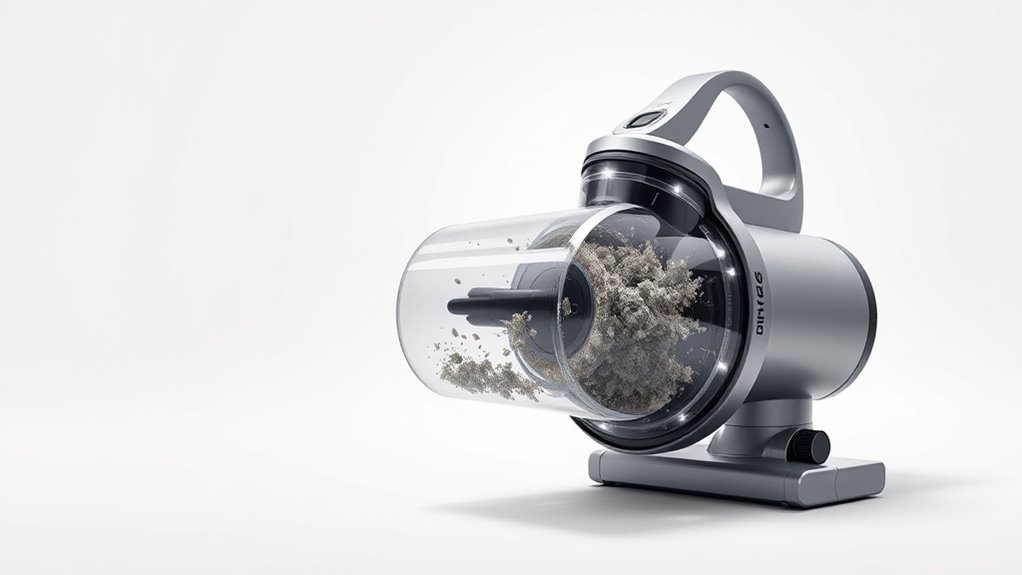
When selecting a cyclone vacuum, focusing on key features can guarantee you get a model that meets your cleaning needs and delivers long-lasting performance. First, check for easy filter maintenance to guarantee ideal airflow and hygiene. Second, consider noise levels; quieter models make cleaning less disruptive. Third, look for strong suction power to handle different floor types effectively. Fourth, evaluate the vacuum’s capacity and maneuverability, especially if you have large spaces or stairs. Additionally, assure the filter system is durable and easy to access for regular cleaning. Incorporating suction technology can further improve cleaning efficiency across various surfaces. These features will enhance your experience and prolong the vacuum’s lifespan, making your investment worthwhile. Prioritize these aspects to find a cyclone vacuum that suits your home and lifestyle perfectly.
Future Innovations in Cyclone Floor Care Technology
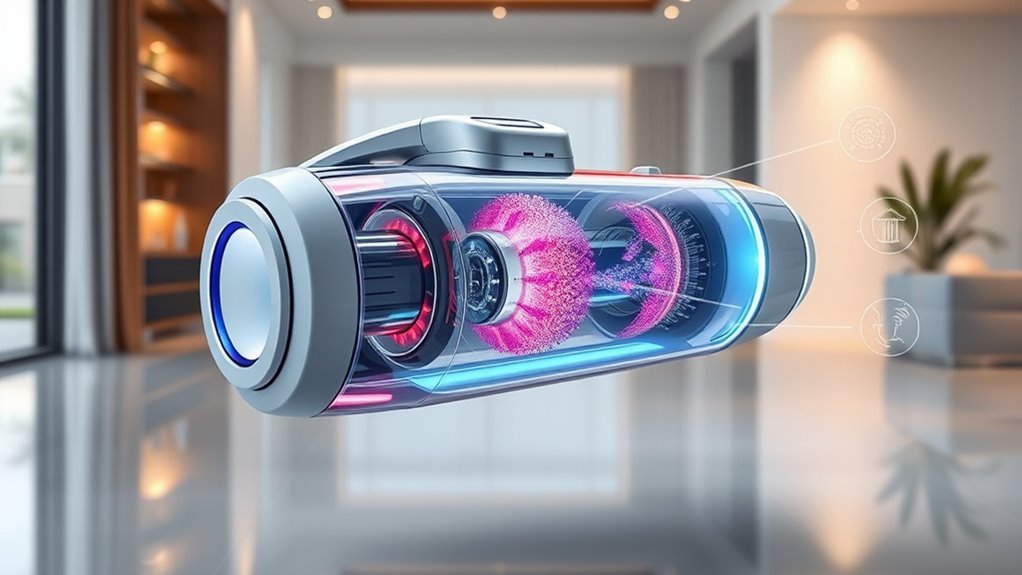
Advancements in cyclone floor care technology are poised to revolutionize how you clean your home. Future innovations will focus on enhancing dust control and noise reduction, making your cleaning experience quieter and more efficient. Expect smarter vacuums with improved cyclone designs that trap even microscopic dust particles, preventing clogs and maintaining suction power longer. Additionally, noise reduction technology will make vacuums less disruptive, perfect for late-night cleaning or homes with children. Manufacturers are exploring lightweight materials and soundproofing features to achieve this. Here’s a glimpse of what to anticipate:
| Innovation | Benefits | Impact on You |
|---|---|---|
| Advanced cyclone designs | Better dust separation | Cleaner air, less dust mess |
| Quieter motors | Reduced noise levels | Quiet operation |
| Lightweight materials | Easier to maneuver | Less fatigue |
Frequently Asked Questions
How Does Cyclone Technology Affect Vacuum Noise Levels?
Cyclone technology helps reduce vacuum noise by improving airflow, which minimizes sound output. You’ll notice less noise because the design incorporates sound dampening materials and noise reduction techniques that control how sound waves travel. This means your vacuum operates more quietly, making cleaning less disruptive. The efficient airflow also prevents loud motor strain, further lowering noise levels and creating a more comfortable cleaning experience for you.
Can Cyclone Vacuums Handle Pet Hair Better Than Traditional Models?
Think of your cyclone vacuum as a mighty storm, fiercely sweeping away pet hair. It handles pet hair removal more effectively than traditional models, pulling stubborn fur deep into its cyclone vortex. This powerful system also improves allergen containment, trapping dust and pet dander better. So, with each use, you’re not only cleaning thoroughly but creating a healthier home environment, free from lingering allergens and pet hair chaos.
Are Cyclone Vacuums More Environmentally Friendly?
Yes, cyclone vacuums are more environmentally friendly because they often have better energy efficiency, reducing power consumption. They also tend to use sustainable materials in their construction, supporting material sustainability. By using less energy and eco-friendly materials, these vacuums help lower your carbon footprint, making them a greener choice for your home. Plus, their durable design means they last longer, reducing waste over time.
What Maintenance Is Required for Cyclone Vacuum Systems?
You need to regularly perform maintenance on your cyclone vacuum system to keep it running smoothly. This includes replacing filters when they become dirty or clogged, cleaning the dust container to prevent debris buildup, and inspecting the cyclone for blockages or damage. By staying proactive with filter replacement and dust container cleaning, you guarantee peak suction, extend your vacuum’s lifespan, and maintain effective cleaning performance consistently.
Do Cyclone Vacuums Work Effectively on All Floor Types?
Yes, cyclone vacuums work effectively on all floor types because they offer a large dust capacity and excellent suction power. You’ll find them easy to use across carpets, hardwood, and tiles, thanks to their versatile design. Their cyclone technology guarantees consistent airflow, making cleaning more efficient. So, whether you’re tackling a quick spill or deep cleaning, a cyclone vacuum adapts easily to different surfaces, simplifying your floor care routine.
Conclusion
By understanding cyclone technology, you can make smarter choices for your floor care. Imagine upgrading from a traditional vacuum and noticing how less dust escapes and cleaning becomes quicker. For instance, a busy family switching to a cyclone system reports fewer clogs and better suction, saving time and effort. Embracing these innovations means your home stays cleaner longer, with less hassle—making cyclone vacuums a smart investment for any home.
